
Neil Schwartz Photography

Audio By Carbonatix
If the Danelle Project has been a spinning wheel of art and expression, Rob Moore has been the hub for nearly a decade. The nonprofit group aims to raise awareness about Danelle Plaza’s artistic and commercial legacy, and under Moore’s vision and leadership, the space at Southern and Mill avenues went from a derelict eyesore to what some artists and residents have dubbed “the last cool place in Tempe” – a grassroots-organized haven for local artists of all experience and skill levels.
To be sure, the plaza’s buildings are less-than-stunning, stout midcentury structures desperate for a fresh coat of paint. But walk by their walls and vast windows and you’ll see enigmatic sculptures, paintings, a grid of televisions, a post-apocalyptic neon desert landscape and murals, including one by Lucretia Torva of a child pointing and exclaiming, “Look MA… it’s Tempe!”
The “plaza” is more of a 21,000-square-foot strip mall, at the center of which are two long buildings parallel to each other and separated by parking spots. But the label refers back to its original intended purpose. In 1963, Downtown Tempe and Mill Avenue were aging and looked on as outdated. The city’s leaders considered building a new city hall closer to the southern part of town, where the city was rapidly expanding, and near the newly planned Superstition Freeway. Danelle Plaza was planned and developed as a suburban business district, not far from the proposed city hall that never came to fruition. (Mill Avenue remained a powerhouse.)
Through the years, the plaza was host to a wide variety of businesses, the most notable being the bar and venue that has been the bedrock of the plaza since 1972: Yucca Tap Room. Today at least a half-dozen businesses still operate there, including a record store, a smoke shop, a church and a car wash.
Phoenix, make your New Year’s Resolution Count!
We’re $13,000 away from our End-of-Year campaign goal, with just a few days left! We’re ready to deliver — but we need the resources to do it right. If New Times matters to you, please contribute today to help us expand our current events coverage when it’s needed most.
Since 2016, its empty retail space has been filled slowly with weird, eccentric art, which all began with Moore’s push to transform the empty retail spaces into a creative hub – but one that is of great monetary value to the city, which sold it to developers last year for $2.75 million.
For the community of artists who have seen the places that exemplify Tempe’s wacky, cerebral soul razed to dirt many times over the years, there’s plenty of skepticism.
“Tempe has a tendency to see that a really cool thing is happening in its town and then say, ‘Well, how can we fuck this up?’ That’s just what they do even if they’re not trying to,” James B. Hunt, better known as the artist NXOEED, told Phoenix New Times in February. “It’s always under the guise of helping artists, but they always end up screwing us in the end. There’s one of these that happens every five to 10 years.”
To the revered Valley artist – who you can always count on to refuse a photograph – Moore’s guiding hand made the plaza one of the last remnants of pre-ASU boom, pre-gentrification culture in Tempe.
“Rob Moore helped foster a really cool thing there,” Hunt said. “There’s a big difference between people showing up at a place because they feel like they have to and people getting really excited and rallying around a place because it’s cool and fun and new. Danelle is that thing.”
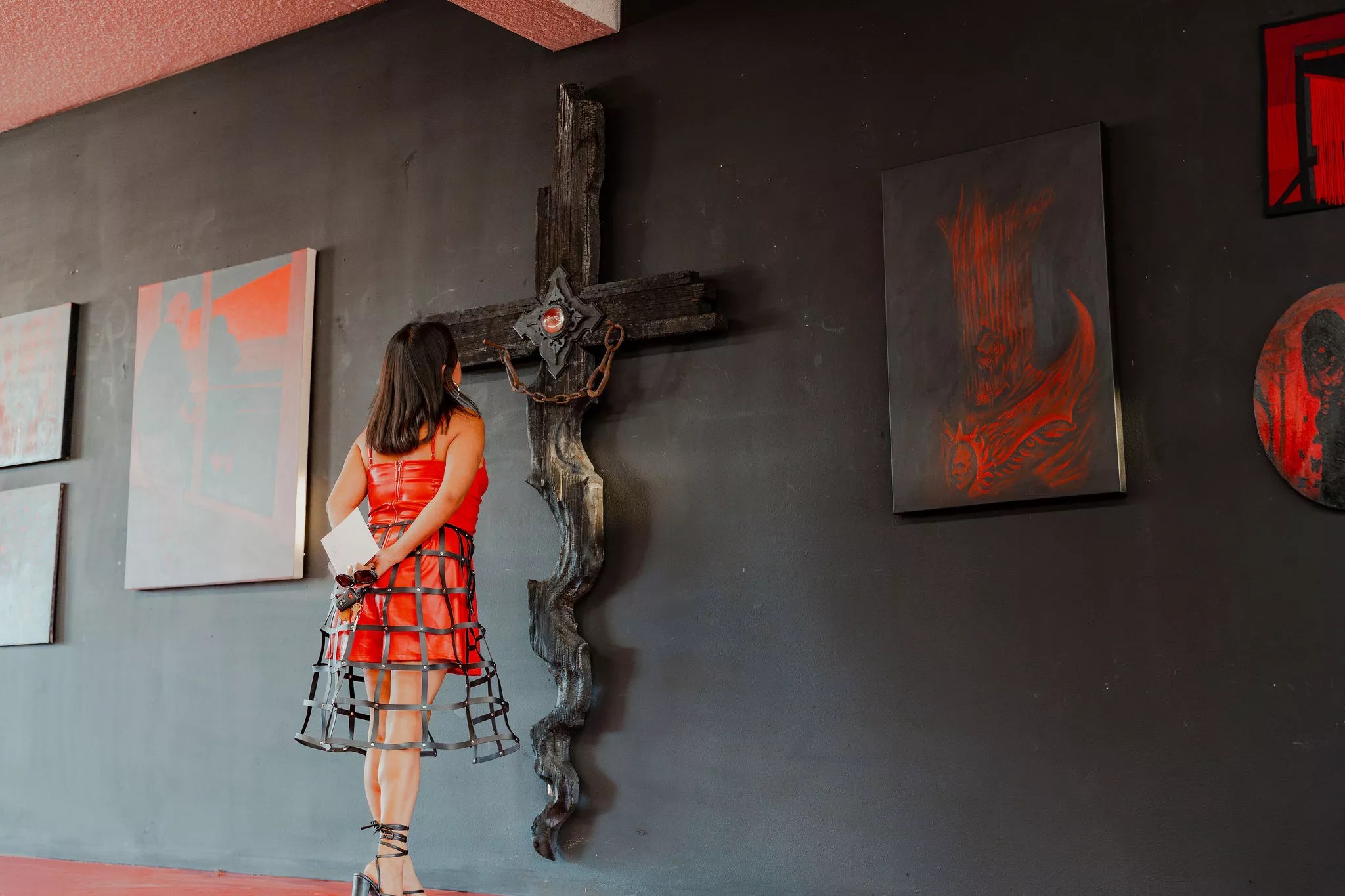
Contemplating a work by artist and “Black and Red” co-curator Matt Dickson.
Neil Schwartz Photography
That essence was on full display April 25 at the Danelle Project’s final two shows – a “Cat Prison” exhibition of 75 cat portraits created by, and a “Black and Red” show featuring the work of about 80 artists, curated by artists Matt Dickson, Luster Kaboom and Seth Manic Tongue.
The “Black and Red” group show in the plaza’s Red Floor Gallery was inspired in part by the room’s color scheme. But entering a smaller chamber within the gallery called La Pequena Galeria – while ducking to get into the mini-gallery that was converted from a bathroom – Moore explained that the theme was conceived of when it became clear that the Danelle Project’s days running the show in the plaza were numbered.
The Danelle Project said much the same on Instagram: “This is the last show and the end of our story,” its post read. “It’s our funeral.”
The collective’s last show managing the DIY space happened against a backdrop of uncertainty: Speculation swirls around the plaza’s fate as two developers are about to give it a makeover. In February 2024, the city signed an agreement with Guina Affiliated Developers and Desert Viking Development LLC to revamp Danelle Plaza, setting out plans for workforce and affordable housing, retail spaces, restaurants and an outdoor concert space. It also contains a condition for art to be placed on new buildings after the “dilapidated” ones in the plaza that currently house art are demolished.
“What’s great is all this effort over the past nine years has led to a development agreement that talks about arts and live music. But there’s tons of question marks,” Moore told New Times, adding that it was essential for people who care to stay involved, keep an eye on the process and keep the plaza community-centric. “We’re at a really critical pivot point.”
But the arts community’s concern over the changes ahead and confusion about City Hall’s mixed messaging came to a head in January. More than 30 people showed up to a Tempe City Council meeting to voice concerns about the future of the plaza.
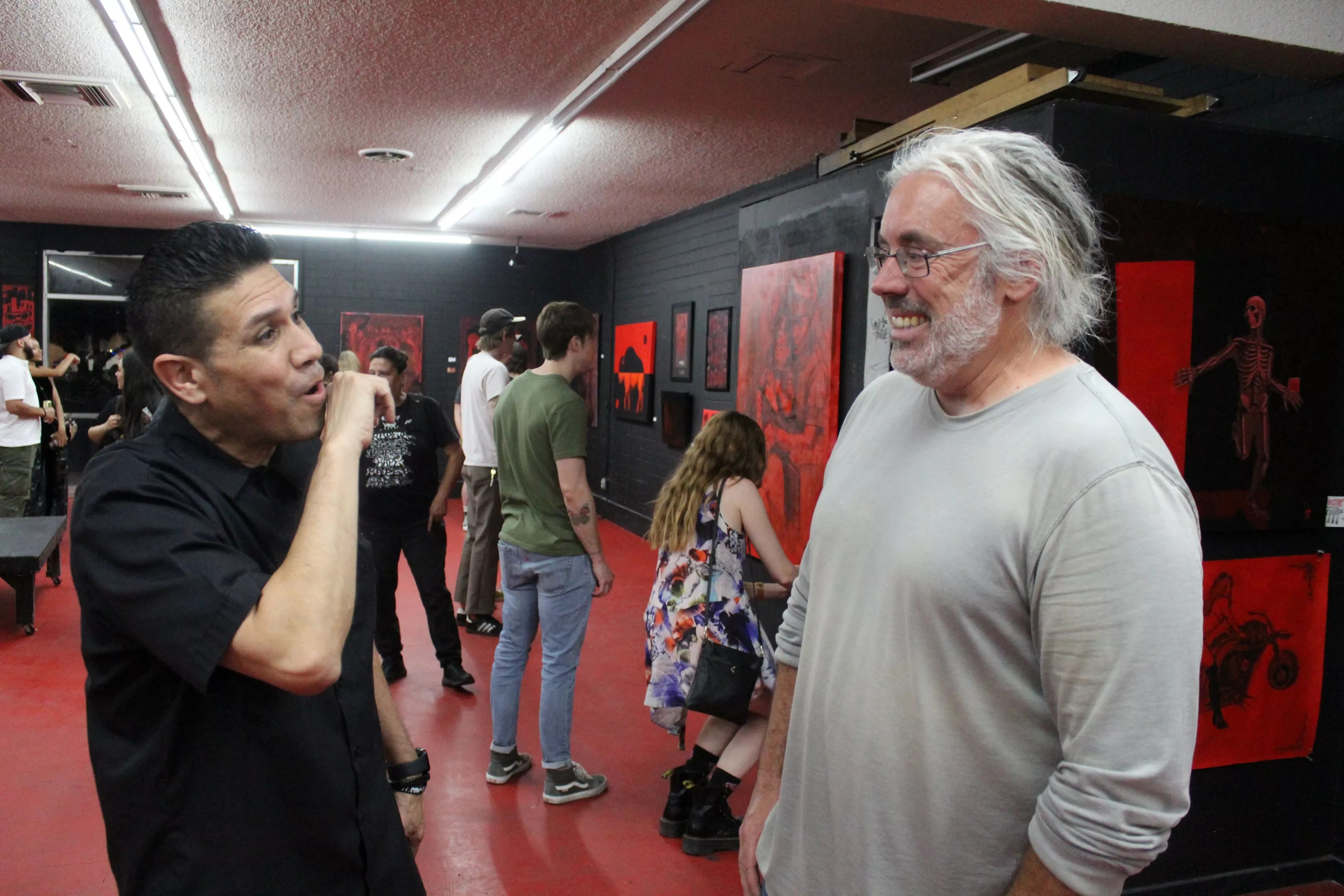
Such Styles, left, and Rob Moore chat during the “Black and Red” exhibition on April 25.
TJ L’Heureux
Eviction notice
Adding to the uncertainty around the plaza’s future and the artistic community’s place in it is a changing of the guard. By February, Moore had already told the city that he would stop financing and programming shows at the plaza at the end of April. But he was still surprised to receive an email from the city of Tempe on March 21 terminating a city lease with his company, Access Geographic, and giving him a month to pack up his belongings and get out.
“I am confused as I don’t recall Access Geographic, LLC having a lease with the City of Tempe?” Moore wrote via email in response to the letter. “I could be wrong!?”
It appears Moore was right. According to Tempe spokesperson Kris Baxter-Ging, the city gave Moore a two-year license in April 2019 free of charge to display and maintain art in the windows of the city’s building. The license expired in 2021, but Moore and the Danelle Project continued to operate there while the city made no effort to get them out. Baxter-Ging said the letter was sent to Moore to “ensure clarity that any implied month-to-month license or lease was officially terminated.”
Moore told New Times he handed over the keys on April 21, just days before the plaza hosted two shows – the last for him as captain of the Danelle Project ship.
Instead of Moore, the Tempe Art and Music Coalition will now be managing the plaza’s artistic evolution. The nonprofit, led by Jacqueline Swan and Moore’s ally Kyllan Maney, entered an agreement with the city to take over and start coordinating programs in May.
Swan told New Times the art isn’t going anywhere, at least for now.
“That’s the first thing we negotiated – to leave the art for the rest of the summer,” she said. “That is not going to be an issue.”

Visitors to Rocket Space Gallery’s “Cultivating Joy” exhibition, which was curated by Kyllan Maney, take part in a collage-making event on Jan. 20.
Jennifer Goldberg
New leadership
The nonprofit, which Maney said has been communicating with the artists who have been involved with Danelle Plaza, plans to move much of the art in the plaza to the building that also houses Yucca Tap Room, which also needs cosmetic work done. TAMC will also continue programming events and exhibitions at the Rocket Space Gallery, another creative space in the plaza, about which Maney said there will be announcements soon.
But the plaza’s long-term fate – and how cool it will remain – is still up in the air. There’s skepticism that the developers and the city will have the artists’ and community’s interest at heart.
“It’s complicated, because there still doesn’t seem to be a clear plan for how long the center building will be there with their intentions for demolition,” Moore said in an interview after the event.
It’s now up, in large part, to the nonprofit. Swan didn’t explain how that happened in the interview with New Times, but an Instagram post made by TAMC shed more light on that.
“A sudden notice for art deinstall was planned for April 21st,” the group wrote. “After our negotiation with the City of Tempe, we made sure the art can stay and began.”
At the April 25 show, Hunt told New Times he has no plans to continue working in the plaza after the developers roll in. He referenced the fact that Desert Viking Development had changed Roosevelt Row in Phoenix from a DIY grungy art spot to more a collection of patio bars that aligns with a less eccentric, more commercial bourgeois aesthetic.
“Like all rad things, somebody comes along and ruins it,” Hunt said.
Baxter-Ging told New Times that once a plan for development takes place, it has to go through the city public involvement process – which includes neighborhood meetings, meetings when it’s discussed by the city’s Development Review Commission and a minimum of two Tempe City Council meetings (the public type, that is).
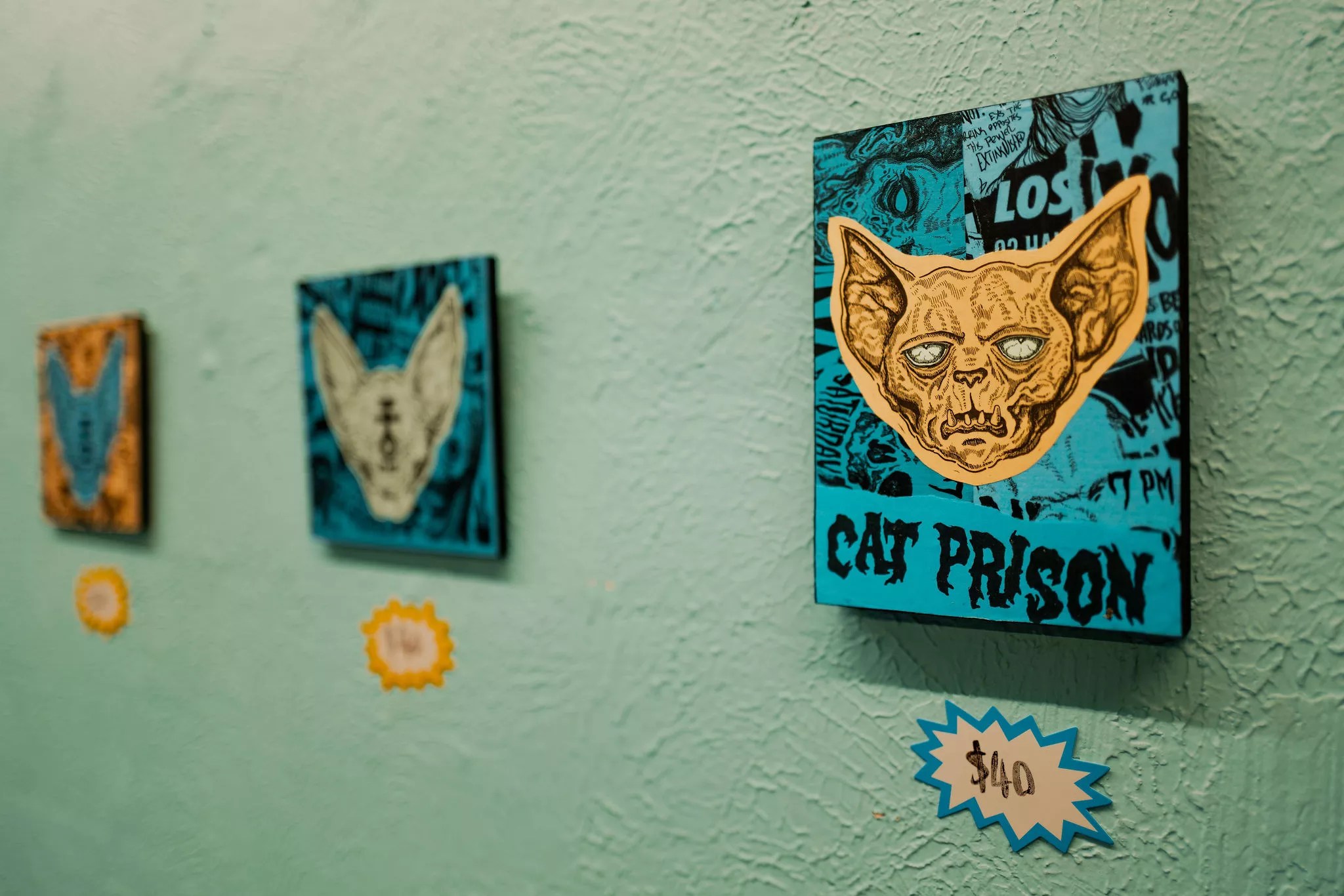
NXOEED’s “Cat Prison” show was held at Danelle Plaza in late April.
Neil Schwartz Photography
Legacy of cool
In 2016, Moore was seeing a show at Yucca Tap Room, a legendary bar and music venue that’s been a mainstay in the plaza since the early 1970s. He noticed that despite its numerous empty retail spaces, the plaza was a center of activity. The observation sparked an idea to fill the empty space, and his position on Tempe’s arts commission helped make his vision a reality: The city allowed him to operate in an abandoned building in the plaza for free.
“We spent nine years exploring how to respect artists and how to understand art scenes,” Moore said.
That scene has been host to a cast of characters making the plaza an unreplicable grassroots space: Maney, a muralist and one of Moore’s early accomplices who helped start art programming at the project; Such Styles, a legendary graffiti artist and driving force in Tempe’s street art culture and arts community in Tempe who has been covering the Valley with his work since the 1980s; Champ Styles, Such’s son whose first mural is at the plaza; Purdy Lites, a talented multimedia artist whose zany, dystopian television installations feature original digital content; Evan Liggins, creator of music and art show Tempe Art a Gogh-Gogh; SlushiePunk, whose “Lady with Rabbit” mural on the southside of Danelle Plaza was her first large-scale mural; JJ Horner, who created the blue mountain installation that honored his late brother; ETUS (Alex Careaga), an artist, musician and film documentarian; and Melissa Waddell, who created the large green arms and legs installation inside one of the plaza’s buildings and has long been part of the Yucca Tap music and arts scene.
That group also includes Taylor “Baconcat” Jensen, a Tempe-raised painter and curator of shows at the plaza. His nickname stems from his habit of telling people the two potbelly pigs he took on leashed walks were his cats, all while pretending to be blind. (Yeah, you read that correctly.)
“It’s supposed to be a little dirty,” Jensen told New Times. “Everyone there is super open. If you just show up and ask, you can be a part of stuff. For my last show, everyone who asked to be a part of it, I was like, ‘yep.'”
Hunt, a veteran of the local arts scene, said that Danelle Plaza has brought artists together in a way that museums and galleries can’t, allowing them to hone their craft and make connections in a welcoming, pressure-free and artistically liberating environment. Frequently spotted at the plaza working on a project, Hunt said passers-by are sometimes drawn in the community just by seeing what he’s creating.
“You start talking to them about art or whatever, and like two weeks later they’re participating in a show and two months later they’ve got an installation of their own or a show somewhere,” he said. “It’s always about the next group of people coming in.”
Dickson, who has curated Red Floor Gallery for the past year, agreed that Danelle Plaza is a creative incubator.
“There’s a huge creative community here and it’s just not funded or there hasn’t been a space for it, and doing the show year goes to prove that there’s this huge want, desire and outcry for it,” he said. “We got to engage the community and since then, I’ve seen more people become active again and take on their own mantle, whether it’s doing other art shows or curating outside of here.”
That accessibility and focus on the community of local artists is what many are worried the plaza could lose.
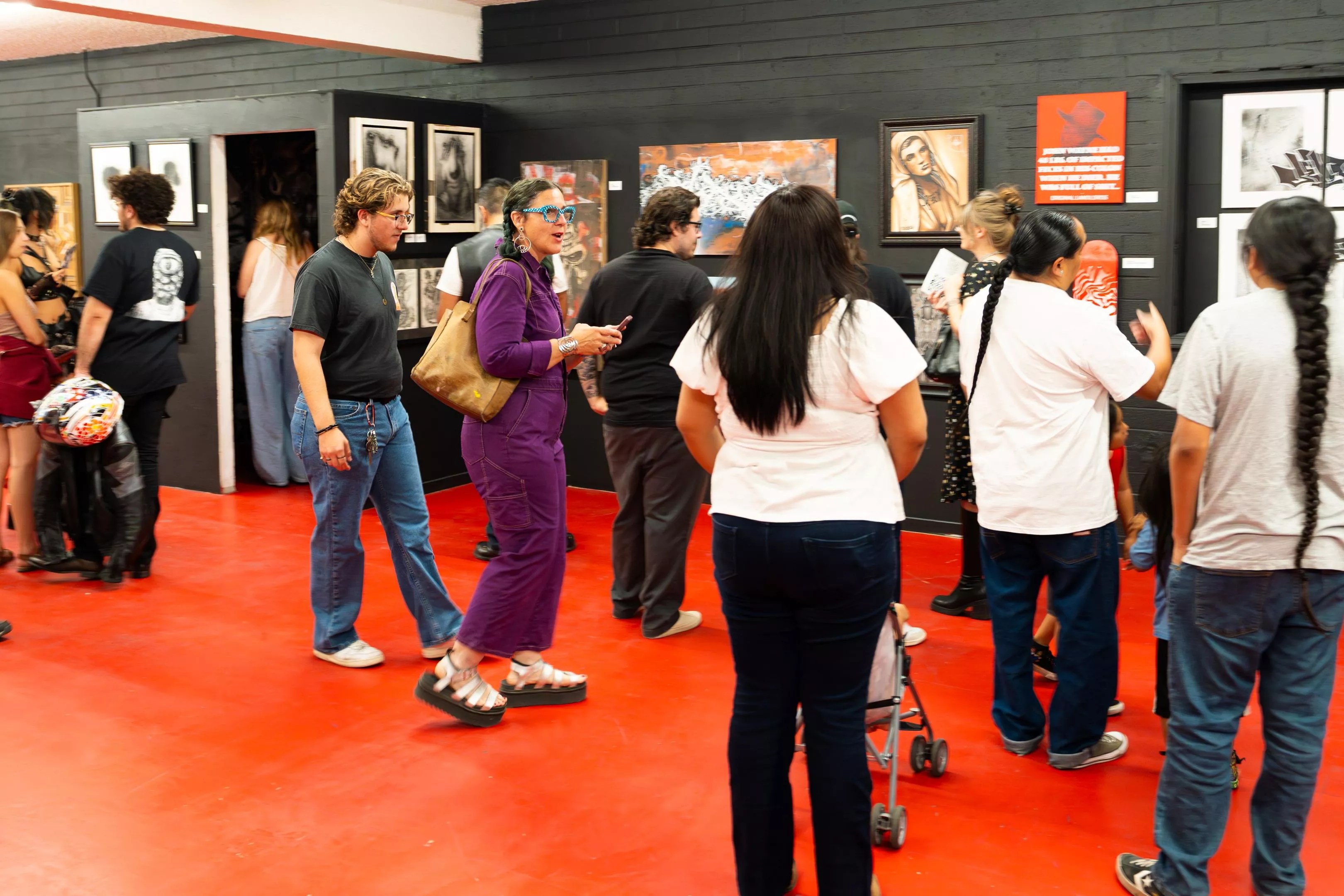
Hundreds of people showed up for “All In,” the first show at Red Floor Gallery in April 2024.
Mike Bengoechea
Fostering creativity
Champ Styles, a local graffiti artist who has followed in the footsteps of his renowned father’s work, told New Times that the Danelle environment grants artists true artistic freedom – an invaluable air that’s hard to come by in the increasingly commercial world of art. While he thinks cactuses and hummingbirds are nice and all, he lauded Danelle for being an environment in which artists are encouraged to follow the wilder sides of their imaginations – exploring themes outside the Valley’s more stereotypical images.
“Danelle Plaza has the opportunity to maintain its identity. It’s the only hub that’s true expressive art, and it’s going to be a challenge for the city to maintain that,” Styles said. “It’s by the people, for the people.”
He argued that developers can’t be trusted to keep it that way, even while the plaza’s rejuvenation is an opportunity to take the plaza to new artistic heights.
“It comes down to the community caring about something,” he said. “My official stance on the whole matter is, if we’re gonna move forward, we gotta work together. I want to see this move on to be bigger and better.”
Maney, the executive creative director of TAMC, the nonprofit that will take over management of the art haven in May, noted that things are bound to change in a few ways. For one, the space won’t be rent-free anymore.
“The galleries were a gift to show and activate space, to see if you gave a space to a community, you could see what the community could do,” Maney told New Times. “That was a gift, and now we have to start paying for the gift. With developers and investors and all that stuff, they have to pay their bills too.”
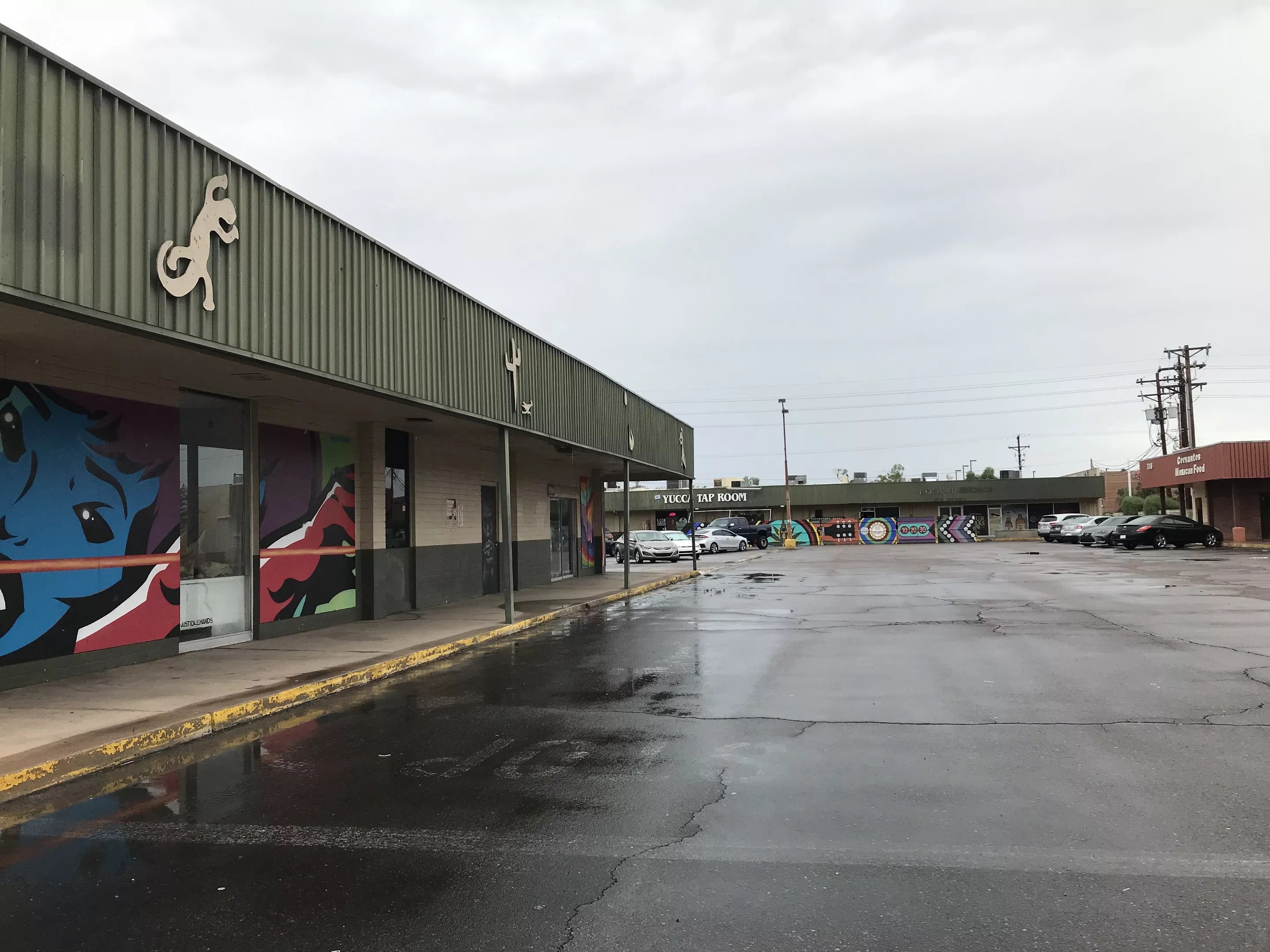
The glass of an art display at Tempe’s Danelle Plaza was damaged by Monday’s microburst.
Lynn Trimble
It’s not really goodbye
Moore said he might be leaving his role at the plaza, but living down the street from it, he plans to stay involved from the wings and keep a close eye on developments (no pun intended) to come. But as the sun set on Danelle Plaza and Moore’s era at the art collective’s helm, that wasn’t front of mind.
The crowded room was full of characters with unique and expressive outfits and style, all mingling between the haunting red and black art. Moore swirled around the room, talking to many of them and reminiscing, including Such Styles.
“It’s the end of a chapter in a really, really good book,” Styles told New Times of the Danelle Project’s run. Moore told stories about what Styles has meant to the project, at one point saying he needed to be careful so he wouldn’t cry. I told him it was a funeral and that it was OK to cry, over which we all shared a laugh.
Several people approaching Moore noted that they liked the Luster Kaboom painting on display that featured him: titled “Leader,” it shows Moore at the door of one of the plaza’s buildings, inserting keys while a cat looks on from inside.
Moore’s take: “I feel bad. It looks like I’m locking that cat in,” he said.
I mentioned that he must be locking the cat into Cat Prison.
“Exactly,” Moore smiled serenely. “It’s a double reference.”
Speaking with New Times two days after the shows, Moore got emotional talking about how he felt after the night at the plaza wrapped up.
“I felt really humbled and fortunate just to be surrounded by so many creative people. There are so many amazing people out there,” Moore told New Times over the phone, choking up. “There’s a lot of pride too. All these people always step up and support the community. And they always come together and create so much beauty. They give so much, you know?”